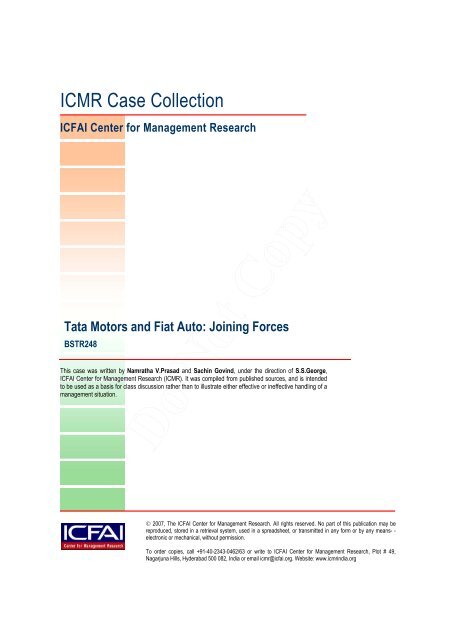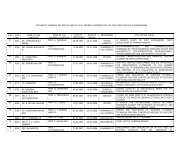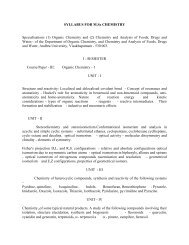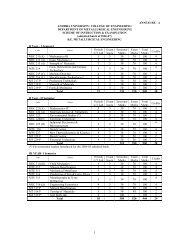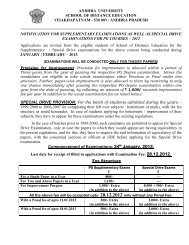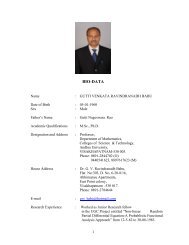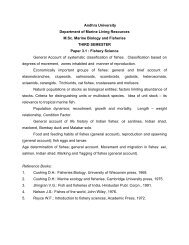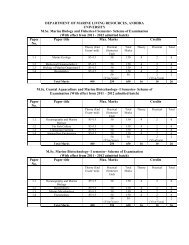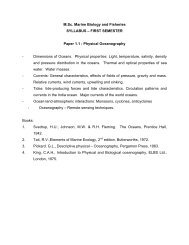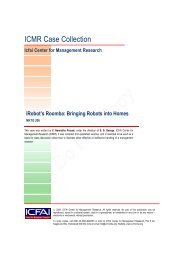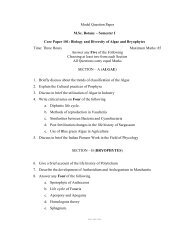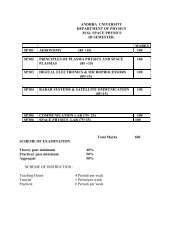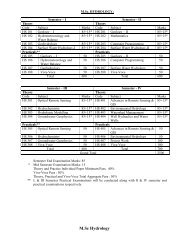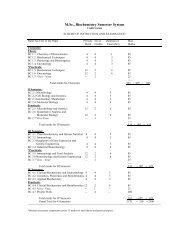ICMR Case Collection - Andhra University, Visakhapatnam
ICMR Case Collection - Andhra University, Visakhapatnam
ICMR Case Collection - Andhra University, Visakhapatnam
You also want an ePaper? Increase the reach of your titles
YUMPU automatically turns print PDFs into web optimized ePapers that Google loves.
<strong>ICMR</strong> <strong>Case</strong> <strong>Collection</strong><br />
ICFAI Center for Management Research<br />
Tata Motors and Fiat Auto: Joining Forces<br />
BSTR248<br />
This case was written by Namratha V.Prasad and Sachin Govind, under the direction of S.S.George,<br />
ICFAI Center for Management Research (<strong>ICMR</strong>). It was compiled from published sources, and is intended<br />
to be used as a basis for class discussion rather than to illustrate either effective or ineffective handling of a<br />
management situation.<br />
Do Not Copy<br />
© 2007, The ICFAI Center for Management Research. All rights reserved. No part of this publication may be<br />
reproduced, stored in a retrieval system, used in a spreadsheet, or transmitted in any form or by any means- -<br />
electronic or mechanical, without permission.<br />
To order copies, call +91-40-2343-0462/63 or write to ICFAI Center for Management Research, Plot # 49,<br />
Nagarjuna Hills, Hyderabad 500 082, India or email icmr@icfai.org. Website: www.icmrindia.org
Tata Motors and Fiat Auto: Joining Forces<br />
1<br />
BSTR/248<br />
“This is the beginning of what promises to be a far-reaching, long-term relationship between Fiat<br />
and Tata.” 1<br />
– Ratan Tata, Chairman, Tata Motors, in 2006.<br />
“While Tata Motors will get technology to develop economically priced small cars and entry-level<br />
sedans and an entry into untapped markets, Fiat India can continue to have a presence in the<br />
Indian market without much investment.” 2<br />
INTRODUCTION<br />
– Kalpesh Parekh, Auto analyst, ASK Raymond James 3 , in 2006.<br />
In July 2006, major Italian automaker Fiat Auto S.p.A. (Fiat Auto), and the Indian auto major Tata<br />
Motors (TM), signed a Memorandum of Understanding (MoU) to form a joint venture to produce<br />
passenger cars, engines, and transmissions in India. These products were intended both for the<br />
Indian and the international market. Earlier, in January 2006, the two companies had signed a<br />
marketing and distribution agreement under which TM marketed select models of Fiat cars<br />
through a few of its dealers. The joint venture was seen as a major development in the Indian<br />
automobile industry.<br />
Both TM and Fiat Auto had a long history in automobile manufacturing. Until the 1990s, TM was<br />
mostly a manufacturer of commercial vehicles. It entered the passenger car market in the 1990s<br />
with the Indica, a 1400 cc small car 4 with a diesel engine, which went on to become a success and<br />
placed TM among the top three passenger vehicle manufacturers in India. However, in 2002,<br />
because of a fall in the demand for commercial vehicles, TM reported a loss. As a part of its<br />
turnaround strategy, it improved its internal efficiencies and also decided to focus on overseas<br />
markets to reduce the impact of demand fluctuations in the domestic market. In 2003, TM returned<br />
to profitability. By 2005, it had a market presence in Thailand, Senegal, South Africa, Turkey,<br />
Europe, and West Asia. However, in spite of its impressive growth, TM was still a small player at<br />
the global level.<br />
Fiat Auto, which built its first car in 1899, also had an illustrious history in the automobile world.<br />
After World War II, it became a major manufacturer of small cars in Italy, and later on in Europe.<br />
Until the 1990s, Fiat Auto dominated the small car market in Europe and other parts of the world 5 .<br />
Do Not Copy<br />
1 “Fiat and Tata announce joint venture in India,”www.detnews.com, July 26, 2006.<br />
2 “La dolce deal?”www.economictimes.indiatimes.com, August 04, 2006.<br />
3 ASK Raymond James Securities India Pvt. Ltd. (ASK RJ) is a joint venture between ASK Investment and Financial<br />
Consultants Ltd. (India), Raymond James Financial Inc. of the US, and Bharat Shah, an investor. It offers portfolio<br />
management services and investment advisory services.<br />
4 A small car, in the Indian context, is a car of length not exceeding 4,000 mm and with an engine capacity not<br />
exceeding 1,500 cc for diesel cars and not exceeding 1,200 cc for petrol cars. They are the most fuel- efficient cars<br />
available in both diesel and petrol variants, and also the cheapest.<br />
5 In 1968, Fiat surpassed Volkswagen as the largest carmaker outside the U.S., with 157,000 employees producing<br />
1.75 million cars a year. Fiat continued to expand through much of the 1970s and 1980s. (Source: www.time.com)
2<br />
Tata Motors and Fiat Auto: Joining Forces<br />
In India, Fiat cars were imported even as far back as 1905. In the 1950s, the Fiat Group entered<br />
into a license agreement with India-based Premier Automobiles Ltd. (PAL) 6 to manufacture its<br />
cars. Fiat Auto formally entered the Indian market in 1997 through a joint venture with PAL.<br />
In the early 2000s, Fiat Auto ran into losses as it was slow in adapting to the changed economic<br />
environment 7 in Italy in particular and Europe in general. Its market share in the Italian and<br />
European car markets declined. Around the same period, Fiat Auto’s share in the Indian<br />
automobile market also fell drastically. In 2002, the company adopted a turnaround strategy which<br />
included several measures like cutting costs, restructuring debts, launching new models, increasing<br />
advertising spend, and focusing on markets where the demand for small cars was high. India being<br />
a major market for small cars, Fiat Auto decided to revive its operations in the Indian market. And<br />
the joint venture with TM was a step in that direction.<br />
Most analysts were of the opinion that the joint venture would benefit both parties; TM would gain<br />
in terms of better accessibility to technology, design, and global markets, while for Fiat Auto, it<br />
would mean a larger presence in India, one of the world’s fastest growing auto markets, without<br />
heavy investments. However, there were others who felt that the joint venture would end in brand<br />
dilution and product cannibalization for both parties. Also, with Honda, Toyota, GM, Mitsubishi,<br />
M&M/Renault, Nissan, Skoda, etc., chalking out plans to enter the small car segment, especially<br />
the premium small car segment, it seemed likely that the TM-Fiat Auto joint venture would face<br />
intense competition in the coming years.<br />
TATA MOTORS<br />
TM had its origins in Tatanagar Shops 8 , which was acquired by Tata Sons Ltd. 9 on June 1, 1945,<br />
from the Government of India (GoI). Tata Sons renamed the company Tata Locomotive and<br />
Engineering Company Ltd. Initially, the company produced steam locomotive boilers and later<br />
graduated to producing complete locomotives and other engineering products. From 1960 onward,<br />
it was referred to as Telco (Tata Engineering and Locomotive Company Ltd.).<br />
Telco began production of medium commercial vehicles in 1954. The company gradually grew<br />
under the leadership of J.R.D. Tata (Chairman between 1945 and 1973), and Sumant Moolgaokar<br />
(Moolgaokar) (Chairman between 1973 and 1988). Telco set up a second factory in Pune in the<br />
1970s. The company started manufacturing heavy commercial vehicles in 1983 and light<br />
commercial vehicles in 1986. Telco also increased its exports over the years. In 1988, Ratan Tata<br />
replaced Moolgaokar as Telco’s Chairman. Under Ratan Tata, the company stepped into the<br />
passenger car segment. Telco began to test several indigenously developed car models in the late<br />
1980s and the early 1990s.<br />
Until 1990, India had a licensing and regulatory regime that stifled competition in the automobile<br />
industry. Due to this, the automobile market was a seller’s market, with customers having to<br />
endure long waiting periods while purchasing new vehicles.<br />
Do Not Copy<br />
6 Premier Automobiles Ltd. (PAL) was established by Walchand Hirachand in 1942. In 1946, in association with<br />
USA-based Chrysler, the company assembled De Soto and Plymouth cars. As of 2006, the company was making<br />
auto components.<br />
7 In the early 2000s, the European Union’s new requirements for open competition came into force. This and the<br />
dismantling of protectionist measures changed the economic environment for businesses in the EU region.<br />
8 Tatanagar is a part of the city of Jamshedpur. The East Indian Railway had a locomotive manufacturing facility at<br />
that place called the Singhbhum Shops or the Tatanagar Shops.<br />
9 Tata Sons Ltd., a holding company, is a successor to the first trading company founded by Jamsetji Tata (the<br />
founding father of the Tata business empire). The Tata Sons Ltd. board is made up of the chairmen or CEOs of<br />
major operating Tata Group companies, and the elected chairman of the board of Tata Sons Ltd. is recognized as<br />
the Group Chairman. The company is based in Mumbai.
3<br />
Tata Motors and Fiat Auto: Joining Forces<br />
However, all this changed with the liberalization of the Indian economy in 1991. The seller’s<br />
market was transformed into a buyer’s market. The 1990s saw the entry of several major global<br />
automobile manufacturing companies into India. In 1991, Ratan Tata took over as Chairman of the<br />
Tata Group.<br />
In 1991, the first utility vehicle (described as a cross between a truck and a car) under the Tata<br />
marquee called the Sierra was launched. This was followed by the Estate in 1992. In the same<br />
year, Telco opened a new factory at Lucknow. In 1994, the company entered into a joint venture<br />
agreement with Daimler-Benz AG 10 for the manufacture of Mercedes Benz passenger cars in India,<br />
an agreement which continued until 2001. The same year, it also launched a multi-utility vehicle<br />
(MUV) called the Sumo.<br />
In 1998, Telco launched the Safari, India’s first sports utility vehicle (SUV). The same year, the<br />
company also introduced the Indica, a small hatchback 11 with an indigenously developed diesel<br />
engine 12 . The launch of the Indica was a defining moment for Telco as it was not only the<br />
company’s first small car, but also India’s first indigenously 13 developed small car.<br />
At the time of launch of the Indica, the small car market in India was dominated by the Maruti<br />
800, a small hatchback manufactured by Maruti Udyog Ltd. (MUL) 14 . The Indica was priced<br />
aggressively to attract Maruti 800 customers. This forced MUL to lower the retail price of the<br />
Maruti 800, which made small cars more affordable to the Indian middle class and consequently<br />
expanded the market for small cars. Telco changed the rules of the game in the Indian automobile<br />
market by providing customers of the Indica with options like air conditioning, power steering,<br />
alloy wheels, and electric windows ⎯ features which till then had been available only in premium<br />
cars.<br />
By 1999, with 115,000 bookings, it was clear that the Indica was a success. Even as the car was a<br />
commercial success, Telco received several complaints from customers on aspects such as<br />
excessive tire wear, engine vibration, and problems with gears. Telco then re-engineered the car<br />
totally and launched it as the Indica V2 (or version 2). This version fixed most of the technical<br />
problems that had plagued the Indica and it went on to become very popular with customers.<br />
Even though Telco was making impressive inroads into the passenger car market, the year 2001<br />
saw the company recording a net loss of about Rs. 5 billion – its first loss in 57 years. This was<br />
attributed to the Indian commercial vehicles market contracting by about 40% during the year. As<br />
Telco was the market leader in the commercial vehicles (light and heavy) segment with a market<br />
share of 74% (in 2001), the impact of this on the company was particularly severe.<br />
Do Not Copy<br />
10<br />
Daimler-Benz AG, founded in 1926 in Germany, was a leading manufacturer of automobiles, motor vehicles, and<br />
engines. In 1998, it merged with US-based Chrysler Corp. to form DaimlerChrysler AG. It sells passenger<br />
cars/SUVs under Mercedes-Benz, Maybach, Smart, Chrysler, Dodge, and Jeep brands and commercial vehicles<br />
under Fuso, Sterling, Orion, Setra, Freightliner, Mercedes-Benz, Thomas, and Western Star brands.<br />
11<br />
A type of automobile design wherein the passenger cabin included additional cargo space accessed through a hatch<br />
tail gate or a flip up window.<br />
12<br />
The engine design was based on the TUD5 Peugeot engine. Telco claimed to have further refined and optimized the<br />
engine to deliver higher standards of efficiency and emission.<br />
13<br />
Telco paid for services to develop technology in accordance with its specifications. Styling was sourced from Italy,<br />
engine design from France, and instrumentation from Japan. But the design process and implementation of the<br />
manufacturing and supply lines was done by Telco. The Indica was launched within three years of conception, at a<br />
development cost of about $400 million as against the international norm of $1.2 billion required to develop a new<br />
car.<br />
14<br />
Maruti Udyog Ltd. was established through an Act of the Indian parliament in February 1981. In 1982, it entered<br />
into a license and joint venture agreement with Suzuki Motor Company (later renamed as Suzuki Motor Corp.). In<br />
1992, SMC raised its stake to 50% and in 2002, to 54.2%. With this, MUL became a subsidiary of SMC.
4<br />
Tata Motors and Fiat Auto: Joining Forces<br />
As part of a turnaround strategy, Telco focused on improving internal efficiencies and<br />
restructuring its debts. It also took measures to increase productivity. These efforts helped it to cut<br />
costs by Rs. 9.60 billion within two years (Telco was able to reduce the cost of raw materials by 65<br />
per cent and of interest costs by 25 per cent). “Our turnaround initiatives during the past two years<br />
were focused on aggressive cost reduction, right-sizing the organization, financial restructuring,<br />
gains in volume and market share, re-engineering processes, organizational transformation, and<br />
launching new products,” 15 said Praveen Kadle (Kadle), executive director (Finance), Telco.<br />
The company improved its overall efficiency, which allowed it to break even at a much lower level<br />
of capacity utilization than before (31% for commercial vehicles and 48% for cars). It adopted the<br />
platform-sharing system, where different vehicle models shared the same manufacturing system<br />
and some key components, which cut down costs as well as the time-to-market. In 2002, it<br />
launched the Indigo, a mid-size three-box car which shared a platform with the Indica.<br />
In 2002-2003, Telco registered a net profit of Rs. 3 billion. In this period, the company worked out<br />
a two-pronged strategy for growth and to protect itself from future downturns in markets. The first<br />
component of the strategy was to enter and establish itself in overseas markets. This, in addition to<br />
aiding growth, was expected to help the company ride out demand fluctuations in the domestic<br />
market. “The international markets mitigate risk and provide a growth opportunity,” 16 said Kadle.<br />
The second part of the strategy was to produce new products in new segments and to increase the<br />
focus on small passenger vehicles.<br />
THE GROWTH STRATEGY<br />
Going Global<br />
In December 2002, Telco signed a manufacturing and supply agreement with the UK-based MG<br />
Rover Group 17 . Under the agreement, Telco was to supply the Indica, suitably modified to meet<br />
the applicable regulatory standards, to MG Rover, which would then sell it in the UK and in<br />
Continental Europe as the City Rover. Telco also planned to simultaneously market the Indica in<br />
Europe through its own distribution network. Ratan Tata said, “This agreement will enhance the<br />
volume throughput of the Indica plant [at Pune] significantly. More importantly, we look at it as an<br />
endorsement by a major international company of Tata Engineering’s [Telco] capabilities in<br />
general, and the world-class acceptability of the Indica in particular.” 18<br />
In keeping with its global aspirations, Telco was renamed as Tata Motors (TM) in September<br />
2003. “It’s all about growth and a bit of international aspiration. We are driving a change in<br />
mindset through this new name, embarking on a journey that will be increasingly global,” 19 said a<br />
Tata spokesperson.<br />
In October 2003, TM won a US$ 19 million tender for the supply of 500 buses to Senegal. It then<br />
set up a bus assembly unit in Thies, Senegal.<br />
15 “The new and improved Tata twins,” www.tata.com, November 09, 2003.<br />
16 “The new and improved Tata twins,” www.tata.com, November 09, 2003.<br />
17 Rover Company Ltd. (Rover), an automobile manufacturer, was set up in 1904. Over its 100-year history it changed<br />
hands several times. It was taken over by BMW, a German automobile company, in 1994. In 2000, BMW sold it to<br />
the Phoenix Corporation. MG (a sports car manufacturing company) was then merged with Rover to form the MG<br />
Rover Group. It was taken over by China-based Nanjing Automobile Group, a Chinese automobile company, in<br />
July 2005.<br />
18 “Tatas to ship Rover-branded Indicas,” www.blonnet.com, December 21, 2002.<br />
19 “Rechristened thus,” www.tata.com, September 28, 2003.<br />
Do Not Copy
5<br />
Tata Motors and Fiat Auto: Joining Forces<br />
In 2004, TM set up a regional office and a special sales team in the UAE to boost its commercial<br />
vehicles business in West Asia. In March 2004, TM acquired Korea-based Daewoo’s commercial<br />
vehicles business. One of the reasons for this acquisition was to gain an entry into the high-volume<br />
Chinese market. “About 60 percent of Daewoo’s total exports goes to China, and it is already<br />
working with a company there to make trucks in China for the local market. So we would use<br />
Daewoo as leverage to strengthen our position in the Chinese market,” 20 said Kadle.<br />
TM had been selling its medium commercial vehicles and buses in the South African market<br />
through Tata Automobile Corporation South Africa (TACSA) since 1997. In 2004, the company<br />
invested Rs. 40 million in a bus assembly unit in Johannesburg. TM also launched its passenger<br />
cars – the Indica and the Indigo – in the South African market that year. The cars were sold<br />
through a network of 20 dealers. According to reports, TM aimed to capture 7% of the South<br />
African passenger vehicle market by 2007-08.<br />
TM was listed 21 on the New York Stock Exchange (NYSE) in September 2004. “We are confident<br />
that the company will benefit from the capital market access that this listing provides,” 22 said<br />
Ratan Tata.<br />
By the end of 2004, TM’s agreement with MG Rover came under a cloud with Rover selling far<br />
fewer City Rovers than expected. Eventually, the agreement came to an end in April 2005, when<br />
Rover was shut down because of financial problems.<br />
However, TM continued to scout for new opportunities overseas. In March 2005, it acquired a<br />
21% stake in Hispano Carrocera SA 23 , a Spanish bus manufacturing company, giving it controlling<br />
rights in the company and an option to buy the remaining stake at a later date. “This strategic<br />
alliance with Hispano Carrocera will give us access to its design and technological capabilities to<br />
fully tap the growing potential of this segment in India and other export markets. Besides, it<br />
provides us with a foothold in developed European markets,” 24 said Ravi Kant (Kant), executive<br />
director (commercial vehicle business unit), TM.<br />
In February 2005, TM launched the Indica in Turkey through a network of 16 dealers.<br />
In September 2005, TM entered into an agreement with Thai Rung Union Car Plc., Thailand’s<br />
largest pick-up truck modifier 25 , to set up a manufacturing unit for pick-ups in Thailand. Thailand<br />
was the largest manufacturing base for utility vehicles after the US and a major market for utility<br />
vehicles 26 . With this venture, TM also hoped to gain access to the ASEAN 27 region. TM also made<br />
known its plans to set up a production base for hybrid and low-cost small cars in this region in the<br />
future.<br />
20 “Fencing with the west,” www.cfoasia.com, April 2004.<br />
Do Not Copy<br />
21<br />
The company listed its depository shares on NYSE through the conversion of its existing international Global<br />
Depository Shares (GDSs) into American Depository Shares (ADSs). The company’s symbol on the NYSE is<br />
‘TTM’. Citibank NA was the depository. With the listing, the company was required to publish its financial results<br />
annually under both the US GAAP and the Indian GAAP.<br />
22<br />
“Tata Motors drives into Wall Street,” www.tata.com, September 28, 2004.<br />
23<br />
The Spanish company had a market share of 25% in the bus market in Spain, and sold its buses in Europe and<br />
several other countries outside Europe. It had its own in-house product development facility for buses and coaches.<br />
24<br />
“Tata Motors to acquire 21 per cent stake in Hispano Carrocera,” www.tata.com, February 25, 2005.<br />
25 A modifier alters the specifications of a vehicle to suit his client’s special needs. Most governments prescribe the<br />
standards for modification so that the ‘modified’ vehicle adheres to safety and other norms.<br />
26 “Can India become a global sourcing hub for small cars?” www.thehindubusinessline.com, May 09, 2004.<br />
27 The Association of Southeast Asian Nations (ASEAN) is a political and economic organization of countries located<br />
in Southeast Asia. The members of ASEAN include Brunei, Cambodia, Indonesia, Laos, Malaysia, Myanmar,<br />
Philippines, Singapore, Thailand, and Vietnam.
New Product Initiatives<br />
6<br />
Tata Motors and Fiat Auto: Joining Forces<br />
Alongside its global forays, TM launched several new products, some of which created new<br />
categories in the Indian market. In 2004, it unveiled plans to launch the Indiva, a seven-seater<br />
MPV. In September 2004, TM launched the Indigo Marina, a station wagon, positioned as a<br />
premium car that combined the luxury of a sedan with the convenience of an MPV. “We believe<br />
that the Indigo Marina will create a new segment in the market. Tata Motors has always<br />
endeavored to grow the market by prying open new segments,” 28 said Dr V. Sumantran, executive<br />
director, engineering research centre and passenger car business unit, TM. The same year, it also<br />
launched an improved version of the Indica V2 and the Sumo Victa, an improved version of the<br />
Sumo.<br />
At the Geneva Motor Show in March 2005, TM unveiled the Xover, a concept car which was a<br />
fusion of a car and a SUV. After gauging customer reactions, TM planned to take a decision<br />
regarding the commercial launch of the car in Europe, India, and some other markets.<br />
In May 2005, TM launched the Ace, a sub-one ton mini-truck that was uniquely positioned<br />
between three-wheeled cargo carriers and light commercial vehicles. The vehicle generated intense<br />
interest as it offered more load carrying capacity than the three-wheeled vehicles, and at a<br />
reasonable price. Moreover, the Ace catered to a segment of the auto industry that was believed to<br />
be less cyclical than the light, medium and heavy commercial vehicles segments. In this period,<br />
TM also launched the Safari Dicor, the Indigo SX series (a luxury variant of the Indigo), the Indica<br />
V2 Turbo Diesel, the TL 4X4 (India’s first Sports Utility Truck), and the Novus (a range of<br />
commercial vehicles).<br />
In September 2005, TM announced plans 29 to launch a Rs. 100,000 car within three years. “The<br />
vehicle would seat four to five people and have a rear engine. It will not be a scooter, threewheeler<br />
or an auto-rickshaw made into a car,” 30 said Ratan Tata. The product was to be positioned<br />
between two-wheelers and the existing entry-level cars.<br />
At the end of 2005, TM continued to be the market leader in the US$ 5 billion Indian commercial<br />
vehicle market (truck and bus) with about 58% market share (See Exhibit I for the market share of<br />
TM in commercial vehicles market in India). The company was the world’s sixth largest<br />
commercial vehicle manufacturer 31 , and the third biggest car maker in India after MUL and<br />
Hyundai (See Exhibit II for the market share of TM in the Indian passenger vehicles market).<br />
International business, including exports, accounted for 18% of its revenues (in 2005-06).<br />
FIAT AUTO<br />
Fiat 32 came into existence on July 11, 1899. The company was established by Giovanni Agnelli<br />
(Giovanni) together with a group of investors. The first Fiat car manufacturing facility was opened<br />
in 1900 in Corso Dante, Italy. Giovanni became the managing director of the company in 1902. In<br />
1908, the company started exporting cars to USA, France, Australia, and the UK.<br />
By 1911, the Fiat Group had diversified into the production and marketing of commercial vehicles,<br />
marine engines, trucks, and trams and by 1925, it had entered the steel, railways, power, and public<br />
transportation businesses.<br />
28 “Tata Indigo Marina set for launch on September 15, 2004,” www.tata.com, September 14, 2004.<br />
29 Tata Motors had first mentioned that it was working on a Rs. 100,000 car project at the 2003 Geneva Motor Show.<br />
However, in September 2005, the company made an official announcement regarding the project and indicated a<br />
time frame for its implementation.<br />
30 “ Tatas’ Rs 1-lakh car to be gearless,” www.rediff.com, August 31, 2005.<br />
31 According to www.tatamotors.com.<br />
Do Not Copy<br />
32 Fabbrica Italiana Automobili Torino or Italian car factory of Turin.
7<br />
Tata Motors and Fiat Auto: Joining Forces<br />
The Fiat Group’s auto division used mass production to keep production costs low. By the late<br />
1950s, the Group had set up several new manufacturing plants abroad for automobiles as well as<br />
for farm machinery. In 1966, Gianni Agnelli (Agnelli), the grandson of Giovanni, became the<br />
Chairman of the Fiat Group. In later years, the Group expanded its operations into areas such as<br />
aerospace and telecommunications with varying degrees of success. In 1967, in its first acquisition,<br />
the Fiat Group purchased Autobianchi 33 . In 1969, it purchased controlling interests in Ferrari 34 and<br />
Lancia 35 .<br />
In 1976, the Fiat Group’s auto division entered the automobile market in Brazil. It also established<br />
production facilities in the country. Later, it entered the Argentinean automobile market. Over the<br />
years, the Group invested heavily in these two markets.<br />
In the 1970s, the Fiat Group’s numerous operations were spun off as independent companies. In<br />
1979, the automobile division of the Group (consisting of Fiat, Lancia, Autobianchi, Abarth 36 , and<br />
Ferrari) was incorporated as an independent company called Fiat Auto S.p.A. By the late 1970s,<br />
Fiat Auto had plants in Italy, Poland, Brazil, and Argentina. In 1986, Fiat Auto took over Alfa<br />
Romeo 37 , a sports car manufacturer. In 1993, it acquired Maserati 38 , another sports car<br />
manufacturing company.<br />
By the late 1980s, Fiat Auto was facing severe competition from Japanese auto manufacturers in<br />
several markets. During this period, Fiat Auto withdrew from the American and Australian<br />
markets.<br />
In the early 1990s, Agnelli was made a senator for life in recognition of his role in developing<br />
Italy’s economy. At that time, the Fiat Group accounted for almost 5% of Italy’s Gross Domestic<br />
Product (GDP) and was also Italy’s biggest employer and something of a national icon.<br />
FIAT INDIA<br />
The Fiat Group’s association with the Indian automobile market goes back to 1905, when it<br />
appointed Bombay Motor Cars Agency as the sales agent for its cars in India. In the 1950s, the Fiat<br />
Group entered into a license and service agreement with PAL, which allowed PAL to manufacture<br />
the Fiat 500 in 1951, the Millicento in 1954, and the Fiat 1100 in 1964. The Fiat 1100 model was<br />
later marketed in India as the Premier Padmini. The Premier Padmini, launched in 1968, went on<br />
to become very popular in India. PAL manufactured and marketed the Premier Padmini until<br />
2000. PAL also launched the 118 NE which combined the body shell of the Fiat 124 with a Nissan<br />
engine. This model was not very successful.<br />
33 Bianchi (later renamed Autobianchi) was established by Edoardo Bianchi in 1899. The cars were built for the<br />
luxury segment with great attention to detail. It produced a very small number of successful small cars. Autobianchi<br />
later came under the control of Lancia.<br />
34 Ferrari was founded by Enzo Ferrari in 1929 to manufacture race cars. Ferrari S.p.A. was established in 1946 to<br />
Do Not Copy<br />
produce street legal cars. The Fiat Group acquired a 50% stake in Ferrari in 1969, which went up to 90% in 1988. In<br />
2002, the Group sold 34% of its stake to Mediobanca, a bank. As of 2006, the Fiat Group had expressed its<br />
intention to acquire the bank’s stake.<br />
35 Lancia was an Italian automobile manufacturer founded in 1906 by Vincenzo Lancia. Lancia was famous for many<br />
innovations in the automobile industry, including the first full-production V6 engine (in the 1950 Aurelia), V8 and<br />
V12 engine configurations, etc.<br />
36 Karl Abarth was a car enthusiast who remodeled cars. Fiat entered into an agreement with Abarth in the mid-1950s,<br />
where Fiat supplied partly constructed cars and Abarth would finish them at his workshop. The remodeled cars<br />
were sold as Fiat Abarths. The first car under the Fiat-Abarth brand was the 750 Berlina, based on the Fiat 600.<br />
37 Alfa Romeo was established in 1907 as Darracq Italiana. It was renamed as ALFA (Anonima Lombarda Fabbrica<br />
Automobili) around 1909 and then as Alfa Romeo in 1920. It came under Fiat Auto in 1986.<br />
38 Maserati was an Italian manufacturer of racing cars and sports cars established by six Maserati brothers in 1914. It<br />
was acquired by the Fiat Group in 1993. In 1997, as part of a restructuring effort, Maserati was brought under<br />
Ferrari. In 2005, Maserati was brought back as a direct subsidiary of Fiat S.p.A., the flagship company of the Fiat<br />
Group.
8<br />
Tata Motors and Fiat Auto: Joining Forces<br />
In 1995, Fiat Auto established a wholly-owned subsidiary in India – Fiat India Auto Ltd (FIAL).<br />
FIAL entered into a 51:49 joint venture with PAL to form Ind Auto Ltd. The joint venture<br />
company manufactured the Uno, a small hatchback, at a plant in Kurla, Mumbai. The production<br />
of the Uno started in 1996. In 1997, FIAL increased its stake in the joint venture to 97%, took over<br />
the Kurla plant, and created a new dealer network. Ind Auto Ltd. was renamed as Fiat India Pvt.<br />
Ltd. (Fiat India). In 1998, Fidis S.p.A., Fiat Auto’s subsidiary in the auto finance business, entered<br />
into a joint venture with Sundaram Finance Ltd. 39 , to form Fiat Sundaram Auto Finance Ltd.<br />
(FISAF) to finance Fiat cars.<br />
Though the Uno received favorable reviews for its design and was considered to be a car that<br />
offered good value for money, it was not a commercial success. Reportedly customer interest in<br />
the product declined over a period of time due to poor customer service and promotion. Fiat India<br />
launched the Siena in 1999 and the Palio in 2001.<br />
FINANCIAL PROBLEMS AT FIAT AUTO<br />
By the late 1990s, Fiat Auto was in deep trouble. Its problems had been building up for years. One<br />
of the main reasons for its problems was that, over the years, it had failed to move beyond the<br />
small car segment to the segments for bigger cars, where margins were higher. Italy’s adoption of<br />
the Euro, the common currency of the European Union, also had an adverse effect on Fiat Auto.<br />
The Italian government’s decisions to withdraw the concessions and subsidies given to the<br />
company, and at the same time, give foreign auto companies free access to the Italian market,<br />
severely affected the company’s revenues and profitability. “The terrible story of Fiat [Fiat Auto]<br />
reflects the protectionism, ineffectiveness, corruption, and compromise typical of the way Italy has<br />
done business for the past 30 years,” 40 said an Italian entrepreneur. However, as much as to the<br />
macro-economic factors, auto analysts attributed the decline of Fiat Auto to the poor quality and<br />
performance of its cars.<br />
Apart from increasing foreign competition, the late 1990s also saw the demand for cars falling in<br />
Italy and some other European countries. The European car industry was burdened with excess<br />
capacity, and Fiat Auto started incurring losses in its European operations because of falling sales<br />
and increasing costs. Other auto companies too were affected and some of them even shut down<br />
their plants in Europe. Fiat Auto, which had invested heavily in expanding the markets in Latin<br />
America, suffered another blow when the region faced a financial crisis in 1998-99. Due to all<br />
these developments, the company found itself in deep financial trouble.<br />
Paolo Fresco (Fresco) became chairman of Fiat Auto in 1998, by which time its market share in<br />
Italy had fallen to 41% from around 62% in 1984. In 2000, the Fiat Group entered into a joint<br />
venture agreement with General Motors 41 (GM). While GM took a 20% share in Fiat Auto, the<br />
Italian company took a 6% share in GM. The deal included a put option, valid between January<br />
2004 and July 2009, which required GM to acquire the Group’s auto business, failing which GM<br />
would have to pay a penalty of US$ 2 billion to the Fiat Group.<br />
By 2002, Fiat Auto had accumulated losses of US$ 2.5 billion, including a loss of $1.3 billion in<br />
2001. The Fiat Group as a whole had debts of almost € 33.4 billion (in 2002).<br />
In 2002, Fiat Auto’s market share was down to 28% in Italy, and a mere 7% in Europe 42 . Its share<br />
price had also fallen by almost 50% over a ten-year period. In the same year, the company<br />
embarked on a restructuring program to deal with the crisis caused by declining sales, increasing<br />
losses, and rising levels of debt.<br />
Do Not Copy<br />
39 Sundaram Finance Ltd., part of the TVS Group, was established in 1954. It is involved in car and commercial<br />
vehicle finance, home loans, software solutions, tire finance, deposits and mutual funds, etc.<br />
40 “Fiat: Running on empty,” www.businessweek.com, May 13, 2002.<br />
41 General Motors was the world’s largest automaker. It was established in 1908 in USA.<br />
42<br />
Fiat had a 14% share in the European car market and a 60% market share in the Italian car market in the early<br />
1990s. (www.time.com)
9<br />
Tata Motors and Fiat Auto: Joining Forces<br />
The crisis at Fiat Auto prompted the Italian government to consider buying a stake in the company.<br />
However, private banks, which were the major creditors of the Fiat Group, preferred a marketguided<br />
restructuring for the company. The Fiat Group received about € 3 billion in credit from the<br />
private banks with a requirement to either sell or turn around its auto business. The Group also<br />
transferred a major share 43 in Fidis Retail Italia (FRI), a subsidiary in the auto finance business, to<br />
the banks. 44<br />
In an effort to cut costs, Fiat Auto announced its intention to trim its workforce. The proposal met<br />
with stiff resistance not only from the labor unions but also from the Italian government. However,<br />
the company went ahead and in 2002, cut more than 8,100 jobs at its factories in Italy. It also<br />
increased investment in R&D 45 and new product development.<br />
The Fiat Group also sold some of its industrial assets to pay off loans. In 2003, the Group sold its<br />
insurance and aviation businesses and in February 2004, its engineering and power businesses (See<br />
Exhibit III for the corporate structure of the Fiat Group).<br />
Through the early 2000s, Fiat Auto saw the entry and exit of four chief executives. These frequent<br />
changes in leadership had their impact on the restructuring process. In June 2004, Sergio<br />
Marchionne (Marchionne) became the CEO of Fiat Auto. He initiated further cost-cutting<br />
measures, and fired managers whose performance was unsatisfactory. He also drew up a schedule<br />
for new model launches, refurbished Fiat Auto’s European showrooms, and increased advertising<br />
expenditure. In this period, Fiat Auto also adopted a strategy to develop new feature-rich models,<br />
which could be sold at higher prices.<br />
These measures were taken to revive the fortunes of Fiat Auto so that the Group would not have to<br />
sell the company to GM. However, with losses mounting, the Fiat Group was forced to consider<br />
the put option. GM, whose European operations (which primarily consisted of the Opel and<br />
Vauxhall brands) were themselves making losses, was not keen to acquire yet another loss-making<br />
car manufacturer. Therefore, it started negotiations with the Fiat Group to extricate itself from the<br />
deal. On May 13, 2005, the agreement between GM and the Fiat Group was dissolved and GM<br />
paid the Group US$ 2 billion (€ 1.55 billion) as penalty. GM also returned its stake (10%) in Fiat<br />
Auto to the Fiat Group.<br />
Amidst the growing consolidation in the global auto industry, Fiat Auto’s market share continued<br />
to shrink rapidly. Fierce competition and high levels of overcapacity in the developed countries<br />
made Fiat Auto look to markets in developing countries, especially India and China. Fiat Auto’s<br />
expertise in small cars gave it an advantage in these markets, where small, cheap cars were in great<br />
demand. Also, generally, the cars sold in developing countries were much simpler (in that they<br />
offered fewer features as options, and used less complex technology) than those sold in mature<br />
markets, resulting in lower product development costs.<br />
However, in the mid-2000s, Fiat Auto’s Indian operations were faring badly, even though the<br />
company had, over the years, invested more than Rs. 20 billion. The Palio was initially very<br />
successful, and Fiat India even started work on a second manufacturing facility at Ranjangaon,<br />
Maharashtra. However, the car’s popularity waned very quickly. Fiat India’s other products – the<br />
Siena (later relaunched as the Petra), and the Palio Adventure also fared badly. The company<br />
faced a situation where its sales declined and its plant was underutilized. To add to its problems,<br />
the Kurla plant (which had an annual capacity of 60,000 cars) was severely damaged by floods in<br />
the middle of 2005, bringing production at the plant to a halt 46 .<br />
43<br />
The Fiat Group sold 51% of its stake in FRI to four banks – Capitalia, Banca Intesa, San-Paolo-ISI, and UniCredito<br />
– for € 370 million.<br />
44<br />
“Fiat agrees sale of Fidis to banks,” www.italiaspeed.com, March 14, 2003.<br />
45 In 2004, Fiat Auto announced that it would invest US$ 4.92 billion on R&D over four years (2008).<br />
46 Production resumed only in the first half of 2006.<br />
Do Not Copy
10<br />
Tata Motors and Fiat Auto: Joining Forces<br />
In March 2005, Paulo Castagna (Castagna) was appointed as the managing director of Fiat India.<br />
Around this time, several Indians were appointed to top management positions. In June 2005, Fiat<br />
India initiated a 12-month revival plan. “India is a strategic market for Fiat [Auto] and we will take<br />
all measures to make it profitable for us. We are taking a long-term view of the market and hope to<br />
turn around the current position,” 47 said Castagna.<br />
In 2005, Fiat Auto made a fresh infusion of about Rs. 2 billion into its Indian operations. The<br />
company also made efforts to rationalize the dealer and service network, removing nonperformers.<br />
“We are concentrating from the commercial side... restructuring and deepening<br />
relations with the dealer,” 48 said Castagna. The company also announced plans to introduce new<br />
models in India in the near future.<br />
As a part of its initiative to cut costs and reduce risks, Fiat Auto was also working with other major<br />
auto makers on product development, market development, etc. The company had entered into<br />
partnerships with global auto manufacturers like Ford Motor Co., PSA Peugeot Citroen, etc. In the<br />
second half of 2005, there were reports that Fiat Auto was considering teaming up with TM.<br />
TATA MOTORS AND FIAT AUTO: JOINING FORCES<br />
On September 22, 2005, TM announced that it was signing a Memorandum of Understanding<br />
(MoU) with Fiat Auto to explore the possibility of cooperation across different areas in the<br />
passenger car market. The two auto makers were examining the possibility of joint product<br />
development, manufacturing, sourcing, and distribution of products, aggregates, and components.<br />
A 15-member joint team consisting of senior officials from both organizations was set up to study<br />
the viability and the specifics of the nature of cooperation, both in the short and the long term. “If<br />
found feasible, the two companies will enter into definitive agreements in the course of the coming<br />
months,” 49 said an official statement.<br />
Both companies appeared optimistic about the possibilities from the alliance. “We are delighted to<br />
be in dialogue with the Fiat Group on the range of possibilities between the two corporations,” 50<br />
said Ratan Tata. For Fiat Auto, this alliance was in keeping with its global strategy. “The possible<br />
strategic cooperation agreement with Tata Group represents another step in our clearly defined<br />
strategy that calls for targeted alliances across the automobile value chain. It is consistent with<br />
successful ventures established with premier partners,” 51 said Marchionne.<br />
In October 2005, Giovanni De Filippis was appointed as managing director of Fiat India in place<br />
of Castagna.<br />
In January 2006, the TM-Fiat Auto alliance moved another step forward, with the announcement<br />
of a shared dealer network in 11 Indian cities, representing 70% of Fiat India’s market. Under the<br />
deal, TM dealers would sell Fiat cars from March 2006. Moreover, the two companies also<br />
examined synergies in overseas distribution so that Fiat Auto could give marketing support to TM<br />
through its retail network in Europe. “The two big companies have come together looking at<br />
opportunities not confined to India but spreading to other places of the world,” 52 said Ratan Tata.<br />
47 “Fiat works on 12 month revival plan,” www.indiacar.com, September 01, 2005.<br />
48<br />
Ibid.<br />
49<br />
“Tata Motors, Fiat tie up to explore cooperation in passenger car segment,” www.thehindubusinessline.com,<br />
September 23, 2005.<br />
50 Ibid.<br />
Do Not Copy<br />
51 Ibid.<br />
52 “Pact with Fiat our window to the world: Tata,” www.tata.com, January 14, 2006.
11<br />
Tata Motors and Fiat Auto: Joining Forces<br />
The new TM-Fiat Auto India dealer network consisted of 25 TM dealers and three Fiat India<br />
dealers. The 28 dealers were to sell Fiat’s Palio and Palio Adventure in addition to all TM<br />
passenger cars – the Indica, Indigo, Indigo Marina, Sumo, and Safari – through 44 outlets. These<br />
dealers were to offer service and spare parts for both Fiat and TM cars. Moreover, the co-operation<br />
extended to vehicle finance as well. According to the deal, Fiat cars were to be financed through<br />
Tata Motor Finance, the finance division of TM.<br />
The two companies also announced that discussions were on to identify new areas for cooperation.<br />
Officials said that new agreements would be reached as and when their feasibility was<br />
established. It was also announced that Fiat Auto would give TM access to its technology and<br />
there was also a possibility of the two companies sharing platforms in the future. “This is not a<br />
joint venture, but this is the start of a relationship which could go beyond even a joint venture. It is<br />
a relationship which is beginning to form. We want to give it time,” 53 Ratan Tata said.<br />
Fiat Auto’s alliance with TM took place against the backdrop of a revival in sales in Europe. The<br />
company earned a quarterly trading profit for the first time in nearly four years in the last quarter<br />
of 2005. This came about mostly because of the high sales of its new model – the Grande Punto<br />
(Refer Exhibit IV for a photo of the model). In the first half of 2006, Fiat Auto earned an operating<br />
profit of US$ 184 million from revenues of US$ 14.8 billion (See Exhibit V for financials of Fiat<br />
Group and revenues by sector).<br />
Meanwhile, TM continued with its forays into international markets. In May 2006, the company<br />
entered into a 51:49 joint venture with Brazil-based Marcopolo 54 to build buses and coaches for the<br />
Indian as well as the overseas markets, at a production facility to be set up in India at an<br />
investment of Rs. 1.5-2 billion.<br />
In mid-2006, Fiat India began using the paint booth facility at its Kurla complex for painting the<br />
Tatamobile 207, TM’s pickup. This was done to increase the utilization of Fiat India’s facilities.<br />
“We are painting 3,000-4,000 bodies of the Tatamobile on a monthly basis, thus optimizing the<br />
paint booth facility. The idea is to be self-sufficient through internal means and the paint booth<br />
plays an instrumental role in sourcing revenue for the company,” 55 said Filippis. Around this time,<br />
the alliance between the two companies was further strengthened by Ratan Tata joining the board<br />
of Fiat S.p.A. 56 .<br />
In July 2006, TM signed another MoU with Fiat Auto for setting up a joint venture in India to<br />
manufacture passenger vehicles, engines and transmissions. The joint venture was to manufacture<br />
both TM and Fiat vehicles for the Indian and overseas markets. Fiat India transferred its facility at<br />
Ranjangaon, where 100,000 cars and 250,000 engines and transmissions were to be produced, to<br />
the joint venture. The two companies were expected to jointly build Fiat cars in the B and C<br />
segments (The Fiat Grande Punto and a new Fiat sedan) and its successful small diesel engine for<br />
Indian as well as export markets. “Fiat [Auto] has technology ... and the opportunities are<br />
endless,” 57 said Ratan Tata. The joint venture was expected to commence production in late 2007<br />
or early 2008.<br />
53 “Tata Motors, Fiat in joint drive — Marketing tie-up is first step towards deeper relationship,”<br />
www.thehindubusinessline.com, January 14, 2006.<br />
54 Marcopolo, founded in 1949 in Brazil, manufactured bodies for a whole range of coaches, e.g. microbuses, and<br />
inter-city and touring coaches. It had manufacturing plants in Brazil, Argentina, Colombia, Mexico, Portugal, and<br />
South Africa. It also exported its coaches to more than 60 countries of the world.<br />
55 “Fiat paints Tatamobile bodies at its plant,” www.blonnet.com, June 28, 2006.<br />
56 Fiat S.p.A. is the holding company in the Fiat Group.<br />
Do Not Copy<br />
57 “Fiat and Tata plan India venture,” www.news.moneycentral.msn.com, July 24, 2006.
12<br />
Tata Motors and Fiat Auto: Joining Forces<br />
Fiat Auto and TM also commissioned a 60-day study aimed at exploring industrial and commercial<br />
cooperation in Latin America. The study was to examine the prospect of using Fiat Auto’s<br />
production units in Cordoba, Argentina, to manufacture Tata vehicles, especially utility vehicles<br />
and pick-ups, and market them in South America and other markets.<br />
The July MoU was an indication of the growing commitment and co-operation between the two<br />
companies to work together and use their combined strengths to capture key markets. “Both<br />
companies have complementary strengths, convergent objectives, and shared values. Together, we<br />
can meaningfully address markets in India and other select geographies, combining technologies,<br />
products, and human skills of both organizations,” 58 said Ratan Tata.<br />
The companies also had plans to expand the dealership network in India. Though the two<br />
companies did not reveal their investments in the venture, analysts estimated that it would be<br />
around of Rs. 2.2 billion.<br />
Moreover, the Fiat Group intended to take TM’s assistance in establishing a market for its truck<br />
unit Iveco 59 in India. Iveco earlier had a stake in Ashok Leyland (the second largest commercial<br />
vehicle manufacturer in India), through which it had sold its cargo range of trucks in India.<br />
However, with sales being less than satisfactory, the range was phased out within a few years of its<br />
launch. TM and Fiat were also looking for other areas where they could partner. “There will be<br />
additional alliances that we will disclose as they are concluded,” 60 said Marchionne.<br />
ADVANTAGES OF THE ALLIANCE<br />
Even though Fiat India had been present in India for close to a decade, it had the lowest market<br />
share among the 11 players 61 – including later entrants like Skoda India – in the growing car<br />
market. Though the company’s cars like the Palio were initially quite successful, Fiat’s image<br />
suffered due to its dealers. Fiat customers were reported to have faced problems because of the<br />
non-availability of spare parts and lackadaisical customer service. Such problems had an adverse<br />
impact on the company’s image, and it struggled to compete effectively in the Indian automobile<br />
market. The alliance with TM was expected to improve its dealership network and customer<br />
service without the company having to make significant investments. The goodwill enjoyed by<br />
TM, and the company’s reach were expected to improve Fiat’s image in India. “This alliance<br />
enables us to increase our customer base in India and also provide superior service and facilities to<br />
our existing customers,” 62 said Marchionne.<br />
Through the alliance, Fiat India also planned to source spare parts for its vehicles from TM. The<br />
Tata Group was a cost effective supplier of auto components and had several manufacturing<br />
companies under the TACO Group 63 . Fiat Auto also had plans to increase the level of component<br />
sourcing for its overseas operations from India to US$ 10 million in 2006. Component sourcing<br />
was expected to be a major area of cooperation between the two companies.<br />
Do Not Copy<br />
58 “Tata-Fiat JV to make passenger cars,” www.indianexpress.com, July 26, 2006.<br />
59 Iveco, a subsidiary company in the Fiat Group, was a leading manufacturer of trucks and buses in Europe.<br />
60 “Fiat and Tata plan India venture,” www.news.moneycentral.msn.com, July 24, 2006.<br />
61 Apart from TM and Fiat India, MUL, Hyundai, Ford, GM, Mahindra & Mahindra, Skoda, Mercedes Benz, Honda,<br />
and Toyota were the other players in India. BMW was also setting up a factory in India and was to begin sales in<br />
2007.<br />
62 “Tatas, Fiat tie up to sell vehicles,” www.tribuneindia.com, January 13, 2006.<br />
63 TACO was established in 1995 by the Tata Group. The group includes Tata Autocomp Systems Ltd., joint ventures<br />
with several global auto manufacturing players and two subsidiaries (plastics and stampings).
13<br />
Tata Motors and Fiat Auto: Joining Forces<br />
According to auto analysts, while the alliance was expected to cut manufacturing costs for Fiat<br />
India (since the manufacturing at the Ranjangaon facility would use the cost efficient production<br />
processes of TM), TM was also expected to improve efficiency. “The tie-up between Tata Motors<br />
and Fiat will provide better synergy for both the companies in terms of operational efficiency and<br />
better utilization of resources,” 64 said HC Raveendra of KR Choksey, a Mumbai-based broking<br />
firm.<br />
Though TM was a force to reckon with in the diesel passenger car segment of the Indian auto<br />
market, it did not possess the latest in diesel engine technology. In contrast, Fiat Auto’s expertise<br />
in diesel engine technology, specifically in the common rail technology 65 , was world-renowned.<br />
The joint venture was expected to strengthen TM’s position in the diesel passenger car segment.<br />
Among the engines to be made under the joint venture was the 1.3 liter next-generation JTDi<br />
diesel engine 66 . Fiat Auto also announced that it would introduce a small diesel engine in India.<br />
Auto analysts expected this to be used in the Rs. 100,000 small car that TM was planning to launch<br />
in 2008.<br />
Though TM was the leader in the diesel segment of the Indian auto market, its presence in the<br />
petrol segment was limited. TM’s Indica petrol version contributed only 5% to its total car sales.<br />
The company was therefore keen on upgrading its petrol engine technology. “We are looking at<br />
getting a larger piece of the petrol market than we have and that is something we must also do. We<br />
cannot only be dependent on the diesel when the proliferation of diesel products is greater than<br />
ours alone,” 67 said Ratan Tata. Through the alliance with Fiat Auto, TM expected to gain access to<br />
next generation petrol powertrains 68 . According to auto industry sources, the TM-Fiat Auto joint<br />
venture was set to produce two petrol engines called the ‘Fire’ range 69 . Both engines were<br />
expected to be used in future models from TM and Fiat.<br />
The joint venture also planned to co-develop new car models. This was expected to help TM to<br />
learn and benefit from Fiat Auto’s expertise, gained through years of producing small cars and<br />
sedans. “The alliance with Fiat [Auto] could help Tata get technologies and designs for new<br />
models in future. It’s a win-win deal for both,” 70 said Kalpesh Parekh, an analyst with ASK<br />
Raymond James.<br />
The Ranjangaon plant was expected to add to TM’s production capacity. The new capacity was<br />
being added at a critical time for the company as its manufacturing facility at Pune had been<br />
working at full capacity.<br />
India was one of the fastest growing car markets in the world, with most of the growth taking place<br />
in the small car segment. In the 2000s, car sales in India had grown by almost 20% annually. In<br />
addition, in 2005-06, the GoI had announced a cut in excise duty on small cars which was<br />
expected to make India the world’s manufacturing hub for small or compact cars. The joint venture<br />
was expected to help TM and Fiat Auto (See Exhibit VI for photographs of some Fiat cars)<br />
compete effectively against MUL and Hyundai Motor Company (Hyundai) – who were<br />
aggressively increasing their production capacities – and to capture a larger share of the small car<br />
market in India<br />
64 “Tata Motors, Fiat in 50:50 JV for cars, engines,” www.finanacialexpress.com, July 26, 2006.<br />
65 Common rail is a modern variant of direct fuel injection system for diesel engines.<br />
66 This engine won the Engine of the Year Award in 2005.<br />
67 “Tata’s grand vision,” www.tata.com, January 15, 2006.<br />
Do Not Copy<br />
68<br />
The powertrain for a vehicle consists of all the components, including the engine, transmission, driveshafts,<br />
differentials, and the final drive (drive wheels, caterpillar track, propeller, etc), that produce power and help the<br />
vehicle travel over road, water or in air.<br />
69<br />
The first was a 1.2 liter, 8 valve, 75 horsepower engine and the other was a 1.4 liter, 16 valve, 95 horsepower petrol<br />
engine.<br />
70<br />
“Tata Motors in pact with Fiat,” www.newstodaynet.com, January 17, 2006.
14<br />
Tata Motors and Fiat Auto: Joining Forces<br />
The joint venture was expected to improve TM’s competitiveness in global automobile markets, as<br />
the company would be able to sell its cars in several regions of Europe, through Fiat Auto’s<br />
distribution network. After the termination of the agreement with the Rover group, TM had been<br />
selling the Indica in Europe on its own. Fiat Auto was expected to take up the distribution of the<br />
car in Europe through its outlets, reciprocating the distribution of Fiat cars by TM in India. Since<br />
Europe was a major market for small cars, TM expected to gain substantial benefits from the<br />
arrangement. “We live in a boundary-less world. We hope to grow beyond the shores of India,” 71<br />
Ratan Tata said.<br />
Fiat Auto also had a very strong market presence in Brazil and Argentina, whereas TM had almost<br />
no presence in Latin America. “Fiat [Auto] has plants in various parts of the world like eastern<br />
Europe and Latin America. Both are areas that we would like to be in and where they have ideal<br />
capacity presence, that is another opportunity of working together,” 72 said Ratan Tata. If the talks<br />
were successful, models like the Sumo and the Tatamobile 207 would be marketed in South<br />
America and in other overseas markets.<br />
THREATS<br />
Even though both firms gained several advantages by co-operating, they also faced significant<br />
threats. The TM-Fiat Auto alliance was expected to face intense competition from other<br />
automobile manufacturers in India, some of who were in the midst of forming their own alliances.<br />
In February 2005, Renault SA formed a 49:51 joint venture with Mahindra & Mahindra Ltd. The<br />
alliance was to launch the Logan, a sedan, which would compete against TM’s Indigo. Toyota<br />
Motor Corp. and its subsidiary Daihatsu Motor Co. Ltd., had plans to launch a new small car for<br />
the Indian market.<br />
More significantly, MUL was all set to challenge TM’s diesel supremacy, by entering the diesel<br />
car market in a big way. It was planning to invest Rs. 32 billion to set up a new car plant and diesel<br />
engine production facility. In 2006, MUL announced that it would launch three new small car<br />
models in the next five years. Also, Nissan and Suzuki (which owned 54.2% percent of MUL) had<br />
entered into an alliance in June 2006. Under this alliance, MUL was to produce a small car (the<br />
Nissan Moco). There were also reports that Nissan had plans to enter the Indian small car market<br />
on its own.<br />
Another potential threat came from GM India. In 2005 and 2006, GM India was able to improve<br />
its market share in India, with successful launches of the Chevrolet Optra and the Chevrolet Aveo.<br />
It planned to launch the Chevrolet Spark, a small car, in India, in mid-2007.<br />
There were reports that Hyundai planned to launch diesel variants of its popular models – the Getz<br />
and the Santro. It also had plans to launch a new small car by the end of 2007. Honda Motor Co.<br />
planned to launch a small hatchback car, for which it was to build a new production facility.<br />
Hindustan Motors 73 had plans to launch the Mitsubishi iCar in India in 2007. Similarly, while<br />
Volkswagen was expected to announce its India plans in late 2006, the Indian arm of its Czech<br />
subsidiary, Skoda India, which had already made a mark in the premium sedan market in India,<br />
was toying with the idea of launching the Roomster, a compact five-seater.<br />
TM’s ambitions in the highly competitive European automobile market were also fraught with<br />
difficulties. Even though the company had demonstrated its ability to compete effectively against<br />
global players in the Indian domestic market, this did not imply that its major export product, the<br />
71 “Tata, Fiat to share car dealer networks,” www.expressindia.com, January 13, 2006.<br />
72 “Tata’s grand vision,” www.tata.com, January 15, 2006.<br />
Do Not Copy<br />
73<br />
Hindustan Motors was making Mitsubishi brand cars including the popular Lancer since 1998 under a tie-up with<br />
Mitsubishi Motor Corporation, Japan.
15<br />
Tata Motors and Fiat Auto: Joining Forces<br />
Indica, was of high quality. The Indica was believed to have succeeded in India primarily because<br />
of the price advantage it offered over other models. However, in the European markets, quality<br />
was a far more significant issue than in the Indian market.<br />
Another worrisome consequence of the plans for joint production and distribution was the prospect<br />
of brand dilution 74 for both companies. TM felt that the joint venture would strengthen its global<br />
expansion initiatives without adversely affecting its market share in India. “Fiat [India] operations<br />
are small when compared to ours…We will have access to their technology, new aggregates and<br />
we will market some of their products,” 75 said Ratan Tata.<br />
TM did recognize the threat from Fiat Auto’s Petra to its Indigo model and planned not to offer<br />
the Petra through its dealers. The Petra, though priced higher than the Indigo, reportedly offered<br />
better ride quality and other benefits 76 . A TM spokesman gave the reason for the exclusion of the<br />
Petra as, “The combined portfolio had been picked keeping in mind the need for complementary<br />
products and models that contributed best to strengthening the Fiat brand in the local market.” 77<br />
OUTLOOK<br />
India was one of the fastest growing automobile markets in the world, with passenger car sales<br />
forecast to reach two million units per annum by 2010. As of 2006, small cars made up more than<br />
two-thirds of India’s passenger car market. Even in the future, at least in the short to medium term,<br />
the small car segment was expected to remain the largest segment of the market. Therefore, in<br />
spite of the intense competition, the TM-Fiat Auto joint venture was aiming to make an impact in<br />
this high-volume segment. “Obviously Tata-Fiat [Auto] JV is entering an over-crowded and a<br />
price sensitive segment. But this [small car] segment which contributes to more than 60% of the<br />
total car sales will remain a key segment in the Indian car market for many years,” 78 said an auto<br />
analyst. Also, the fact that only eight in a thousand Indians owned a car meant that there was a<br />
huge potential for growth.<br />
As of 2006, both TM and Fiat Auto were financially sound (See Exhibit VII for the financials of<br />
TM). Fiat Auto reported a 56 per cent rise in second-quarter (April-June 2006) profits partly due to<br />
the encouraging sales of its new model – the Grande Punto. The Grande Punto had increased Fiat<br />
Auto’s market share in Western Europe to 7.9 per cent from 6.6 per cent a year earlier. The<br />
company also intended to launch several new models in 2007, like the next generation Stilo and<br />
Ducato. Fiat Auto had also formed partnerships with some of the other global car majors. For<br />
example, it announced new industrial ventures in Russia with Severstal Auto and in China with<br />
SAIC Motor Corporation Ltd. TM also saw a rise in sales and exports 79 during this period (See<br />
Exhibit VIII for the sales of TM).<br />
Fiat Auto aimed to increase its market share in India to 5% by 2010. In August 2006, Fiat India<br />
shut down its Kurla plant. It planned to completely relocate its manufacturing operations to<br />
Ranjangaon.<br />
74 Brand dilution happens when products that are not a natural fit are offered in the market place under a particular<br />
company’s corporate identity. This also affects the company’s brand positioning when the new product gives out<br />
messages which differ from the company’s own communications.<br />
75 “Tata Motors-Fiat alliance gets ready for a long drive,” www.telegraphindia.com, December 07, 2006.<br />
76 “Turnaround artist,” www.bsmotoring.com, August 07, 2004.<br />
Do Not Copy<br />
77 “Tata Motors, Fiat India to share dealer network,” www.thehindubusinessline.com, March 07, 2006.<br />
78 “La dolce deal?”www.economictimes.indiatimes.com, August 04, 2006.<br />
79 Tata Motors exported 4,257 vehicles in February compared with 3,290 vehicles in the same month in the previous<br />
year, representing an increase of 29.4 percent. The cumulative sales from exports in the current period amounted to<br />
44,031 vehicles, a growth of 66 per cent over the corresponding period in the previous year.
16<br />
Tata Motors and Fiat Auto: Joining Forces<br />
In September 2006, there were newspaper reports that Fiat Auto was evaluating whether it could<br />
share the Indica platform for a new low-cost car it intended to sell in Europe and in other markets<br />
– a proposal that went even beyond the scope of the July 2006 MoU. “It will be in the short term<br />
as they [TM] have already done most of the work. We will add our know-how, and maybe the<br />
money,” 80 said Marchionne. There were also reports that Fiat Auto might invest in TM’s Rs.<br />
100,000 car project, and that TM might build cars for some of Fiat Auto’s luxury marquees like<br />
Alfa Romeo (See Exhibit IX for the all models of Fiat Auto). Kant said, “Nothing is ruled out and<br />
that includes Fiat [Auto]’s top-end models like the Alfa Romeo.” 81 The new developments<br />
indicated the potential in the joint venture, and the possibilities that remained to be explored.<br />
Do Not Copy<br />
80 Parvathy Ullatil, “Fiat, Tata mull platform sharing,” The Economic Times, September 06, 2006.<br />
81 “Tata Motors plans big push,” www.economictimes.com, September 09, 2006.
Exhibit I<br />
17<br />
Tata Motors and Fiat Auto: Joining Forces<br />
A. Market Shares in the Indian Medium and Heavy Commercial Vehicles<br />
(Goods + Passenger) Segment – Q1 2005-06 (Units Sold)<br />
30.9<br />
11.6<br />
57.7<br />
Tata Motors Ashok Leyland Others<br />
B. Market Shares in the Indian Medium and Heavy Commercial Vehicles<br />
(Goods + Passenger) Segment- Q1 2006-07 (Units Sold)<br />
25.9<br />
4.2<br />
69.9<br />
Tata Motors Ashok Leyland Others<br />
Do Not Copy<br />
Source: Kushan Mitra, “The Sixth Coming,” Business Today, August 27, 2006, p38-40.
Exhibit II<br />
18<br />
Tata Motors and Fiat Auto: Joining Forces<br />
Market Shares in the Passenger Car Market – Q1 2005-06<br />
17.4<br />
19.2<br />
13<br />
50.4<br />
Maruti Hyundai Motor Tata Motors Others<br />
Market Shares in the Passenger Car Market – Q1 2006-07<br />
17<br />
14.4<br />
19.7<br />
48.9<br />
Maruti Hyundai Motor Tata Motor Others<br />
Source: Kushan Mitra, “The Sixth Coming,” Business Today, August 27, 2006, p38-40.<br />
Do Not Copy
Source: www.fiatgroup.com.<br />
Source: www.fiat.com.<br />
Exhibit III<br />
Corporate Structure of the Fiat Group<br />
Exhibit IV<br />
The Grande Punto<br />
19<br />
Tata Motors and Fiat Auto: Joining Forces<br />
Do Not Copy
Exhibit V<br />
Fiat Group Financials 2004-05<br />
20<br />
Tata Motors and Fiat Auto: Joining Forces<br />
(in millions of euros)<br />
Particulars 2005 2004 2003 2002<br />
Net Revenues 46,544 45,637 47,271 55,649<br />
Trading Profit 1,000 50 – –<br />
Operating Result 2,215 (585) (510) (762)<br />
Income/(loss) before taxes 2,264 (1,629) (1,298) (4,817)<br />
Net Income/(loss) before interest 1,420 (1,579) (1,948) (4,263)<br />
Group interest in net income/(loss) 1,331 (1,634) – –<br />
Source: www.fiatgroup.com.<br />
Fiat Group’s Revenues by Sector<br />
(in millions of euros)<br />
Particulars 2005 2004<br />
Fiat Auto 19,533 19,695<br />
Maserati 533 409<br />
Ferrari 1,289 1,175<br />
Fiat Powertrain Technologies 1,966 -<br />
Agricultural and Construction Equipment (CNH Global) 10,212 9,983<br />
Trucks and Commercial Vehicles (Iveco) 9,489 9,047<br />
Components (Magneti Marelli) 4,033 3,795<br />
Metallurgical Products (Teksid) 1,036 910<br />
Production Systems (Comau) 1,573 1,711<br />
Services (Business Solutions) 752 976<br />
Publishing and Communications (Itedi) 397 407<br />
Holding Companies, Other Companies and eliminations (4,269) (2,741)<br />
Total for the Group 46,544 45,637<br />
Source: www.fiatgroup.com.<br />
Do Not Copy
Source: www.fiatautopress.com.<br />
Source: www.whatcar.com.<br />
Exhibit VI<br />
New Models of Fiat Auto<br />
A. Fiat Ducato<br />
B. Fiat Stilo<br />
21<br />
Tata Motors and Fiat Auto: Joining Forces<br />
Do Not Copy
Exhibit VII<br />
Tata Motors: Financials<br />
22<br />
Tata Motors and Fiat Auto: Joining Forces<br />
(In millions of Rupees)<br />
As on ( Months )<br />
Profit / Loss Statement<br />
31-Mar-06(12) 31-Mar-05(12) 31-Mar-04(12)<br />
Net Sales 200374.90 171539.80 128955.50<br />
Operating Income (OI) 204880.70 172658.20 131273.00<br />
OPBDIT 20793.20 19470.30 17894.50<br />
OPBDT 18529.70 17928.80 16279.20<br />
OPBT 13320.30 13427.20 11936.80<br />
Non-Operating Income 7217.80 3097.30 1067.90<br />
Extraordinary/Prior Period -1421.50 -511.30 -3935.80<br />
Tax 3827.80 3643.70 965.50<br />
Profit after tax(PAT) 15288.80 12369.50 8103.40<br />
Cash Profit 20498.20 16871.10 12445.80<br />
Dividend-Equity 4979.40 4521.90 2821.10<br />
Source: www.myiris.com.<br />
Exhibit VIII<br />
Tata Motors: Sales<br />
Unit Sales 2005-06 2004-05 % Change<br />
Medium & HCV 136,964 135,337 1.2<br />
LCV 108,084 74,253 45.6<br />
Utility Vehicles 39,783 37,032 7.4<br />
Passenger Cars 169,512 152,943 10.8<br />
Total 454,343 399,565 13.7<br />
Source: Kushan Mitra, “The Sixth Coming,” Business Today, August 27, 2006, p38-40.<br />
Do Not Copy
Marquee Models<br />
Exhibit IX<br />
Fiat Group: Automobile Models<br />
23<br />
Tata Motors and Fiat Auto: Joining Forces<br />
1 Fiat Panda, Idea, Stilo, Grande Punto, Mutipla, Croma, and Sedici.<br />
2 Lancia Ypsilon, Musa, Thesis, Lybra, and Phedra.<br />
3 Alfa Romeo Alfa 147 GTA, Alfa 156, Alfa 159, Alfa 166, Alfa GT, Alfa<br />
Sportwagon, Alfa Spider, and Brera.<br />
4 Maserati Quattroporte, Gransport, Gransport Spyder, GT, Cambiocorsa, and<br />
MC12.<br />
5 Ferrari F430, F430 Spider, 599 GTB Fiorano, and 612 Scaglietti.<br />
Compiled from various sources.<br />
Do Not Copy
References and Suggested Reading:<br />
24<br />
Tata Motors and Fiat Auto: Joining Forces<br />
1. Lou Ann Hammond, Who owns whom, www.carlist.com, September 07, 2006.<br />
2. Lijee Philip & Nandini Sen Gupta, La dolce deal? www.economictimes.indiatimes.com,<br />
August 04, 2006.<br />
3. Tata Motors, Fiat chart a winning formula, www.economictimes.indiatimes.com, July 27,<br />
2006.<br />
4. Gail Edmondson, Fiat’s comeback - Is it for real?, www.businessweek.com, July 26, 2006.<br />
5. Tata Motors, Fiat in 50:50 JV for cars, engines, www.finanacialexpress.com, July 26, 2006.<br />
6. Razib Ahmed, Tata Motors made good profit but not enough! www.southasiabiz.com,<br />
May 19, 2006.<br />
7. Car makers beware, the Tata-Fiat tag team is here, www.rediff.com, January 14, 2006.<br />
8. Sudhakar Shah, Tata partnership with Fiat would play to strengths, www.wardsauto.com,<br />
September 28, 2005.<br />
9. Rs 1 lakh car in 3 yrs: Tata, www.indiacar.net, September 01, 2005.<br />
10. Raghuvir Srinivasan, Tata Motors: India’s own wheels, www.thehindubusinessline.com,<br />
January 28, 2004.<br />
11. The new and improved Tata twins, www.tata.com, November 09, 2003.<br />
12. S. Muralidhar, More wheels in each segment, www.thehindubusinessline.com, July 27, 2003.<br />
13. What now for Fiat? www.bbc.co.uk, January 24, 2003.<br />
14. Biswajit Chowdhury, An auto giant in distress, www.flonnet.com, December 21, 2002.<br />
15. Comeback kid, www.tata.com, June 24, 2002.<br />
16. Ciao, Paolo, www.economist.com, June 13, 2002.<br />
17. Sudipta Basu, Riding the global wave, www.tata.com.<br />
18. Crisis at Fiat Auto worsens, www.eiro.eirofound.eu.int.<br />
19. www.tata.com.<br />
20. www.thehindubusinessline.com.<br />
21. www.fiat.com.<br />
22. www.indiacar.net.<br />
23. www.siam.com.<br />
24. www.autocarindia.com. Do<br />
Not Copy


